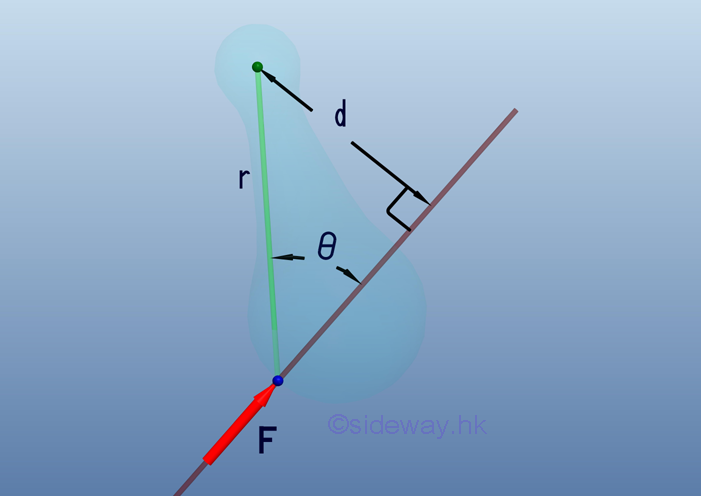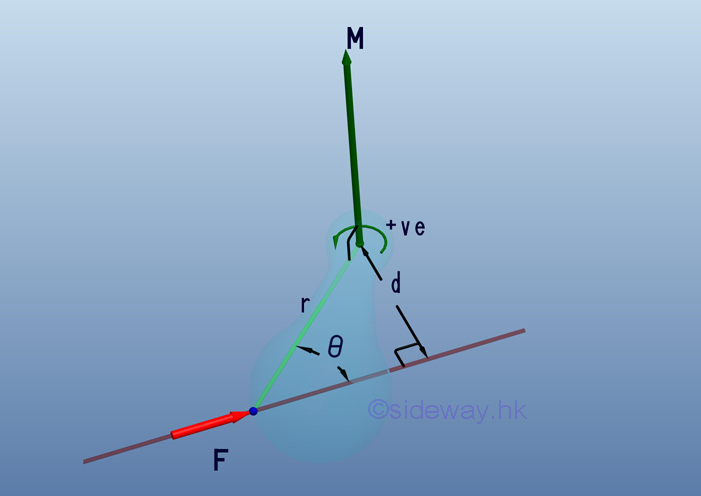Content
Moment of a Force
Rigid Body
Moment
Moment of a Force
In many practical applications, an object subjects to a system of forces cannot be treated as a single particle. By assuming the object as a collection of particles, forces can be considered as acting on different partilcles with different points of application on the object. The force acts on the particle at the point of application on the object will cause the particle to move or translate in the direction of the force. The force acts upon the whole object may therefore twist, or rotate the object. The tendency of a force to rotate an object about a point or an axis is called moment, or moment of a force.
Rigid Body
To simplify the problem, the interested object in elementary mechanics can be assumed to be a rigid body in which deformation is neglected when external forces exterted on it. The external forces are those external action acting on the object externally and causing it to move or to remain at rest. There are also internal forces which act between particles to hold particles together forming the rigid body or act between components to hold component parts together forming the rigid body, or the rigid structure.
Moment
The moment of a force about a point is defined as the product of the force, F, along a line of action and the perpendicular distance, d, between the line of action of the force and the point of reference. Moment of a force about a point determines the tendency to rotate the object about the reference point. The reference point is the center of moment and the perpendicular distance is the moment arm or lever arm of the rotation.

Therefore, the magnitude of the moment , M, concerning with the rotational force can be expressed as:
 or
or

Moment also have both sense and direction. The sense of moment indicates the direction of the rotational force following the right hand rule. And the direction of moment specifies the axis of rotation associated with the rotational force. Therefore, a moment vector at the reference point can be used to represent the moment due to the force about a reference point

By the principle of transmissibility, the force, F, can be replaced by a force acting on a different point with the same magnitude and same direction along the same line of action without changing the conditions of equilibrium or motion of a rigid body.
©sideway
ID: 110500013 Last Updated: 6/2/2011 Revision: 0 Ref:
References
- I.C. Jong; B.G. rogers, 1991, Engineering Mechanics: Statics and Dynamics
- F.P. Beer; E.R. Johnston,Jr.; E.R. Eisenberg, 2004, Vector Mechanics for Engineers: Statics
Latest Updated Links
- Legrand Galion(last updated On 12/2/2025)
- Schneider Electric AvatarOn(last updated On 12/1/2025)
- Alfalux(last updated On 11/30/2025)
- Novabell(last updated On 11/29/2025)
- TownGas NJW12RM1(last updated On 11/28/2025)
- SamSung 42" OLED TV S90F 4K(last updated On 11/27/2025)
- Tefal KI7208 GLASS VISION KETTLE(last updated On 11/26/2025)
- Tefal BL83SD PerfectMix Cook Blender(last updated On 11/25/2025)
- Tefal KI7208 GLASS VISION KETTLE(last updated On 11/24/2025)
- Hitachi RD-290GX Dehumidifier(last updated On 11/23/2025)
- Hitachi RD-290GX Dehumidifier(last updated On 11/22/2025)

 Nu Html Checker
Nu Html Checker  53
53  na
na  na
na
Home 5
Business
Management
HBR 3
Information
Recreation
Hobbies 9
Culture
Chinese 1097
English 339
Travel 18
Reference 79
Hardware 54
Computer
Hardware 259
Software
Application 213
Digitization 37
Latex 52
Manim 205
KB 1
Numeric 19
Programming
Web 289
Unicode 504
HTML 66
CSS 65
SVG 46
ASP.NET 270
OS 431
DeskTop 7
Python 72
Knowledge
Mathematics
Formulas 8
Set 1
Logic 1
Algebra 84
Number Theory 206
Trigonometry 31
Geometry 34
Calculus 67
Engineering
Tables 8
Mechanical
Rigid Bodies
Statics 92
Dynamics 37
Fluid 5
Control
Acoustics 19
Natural Sciences
Matter 1
Electric 27
Biology 1
